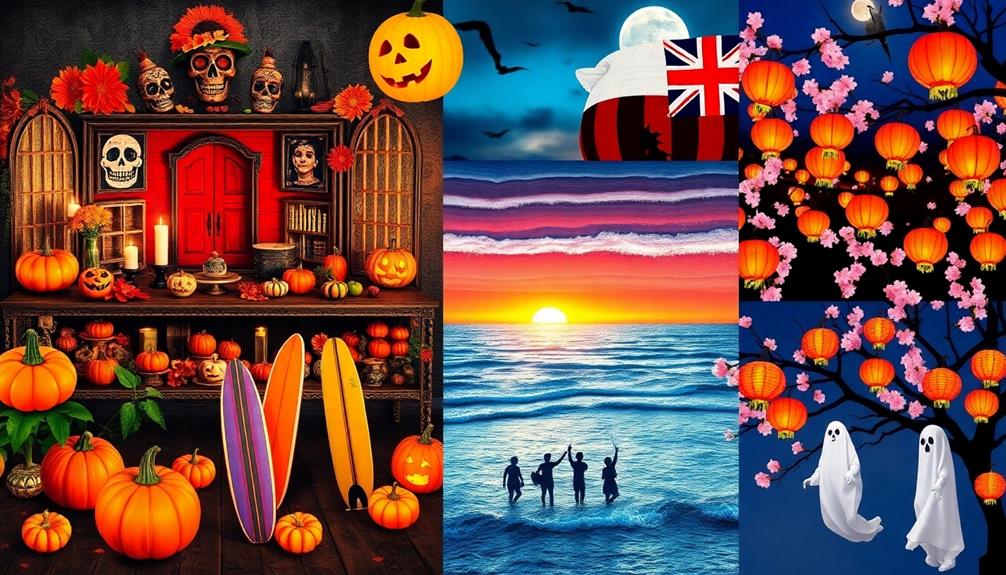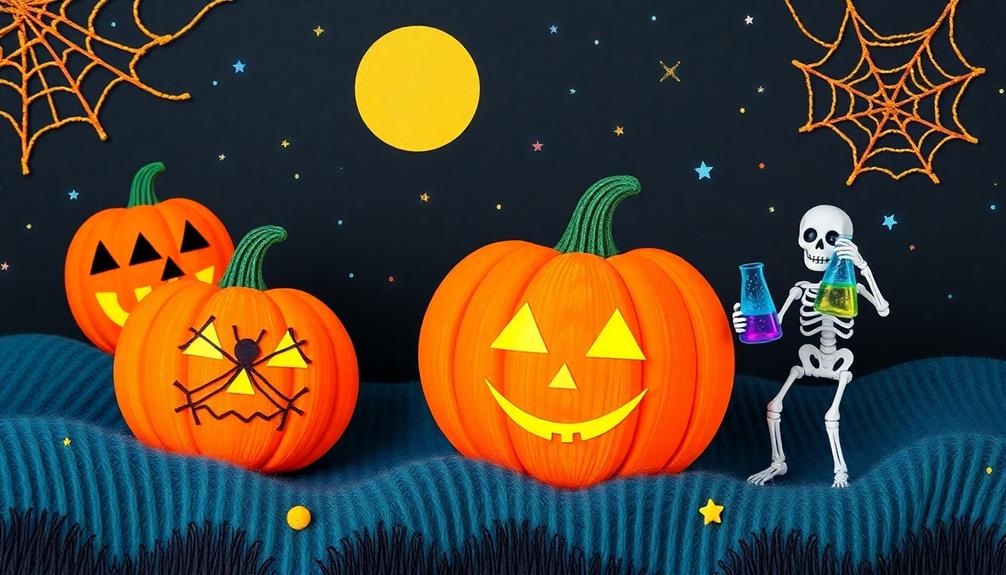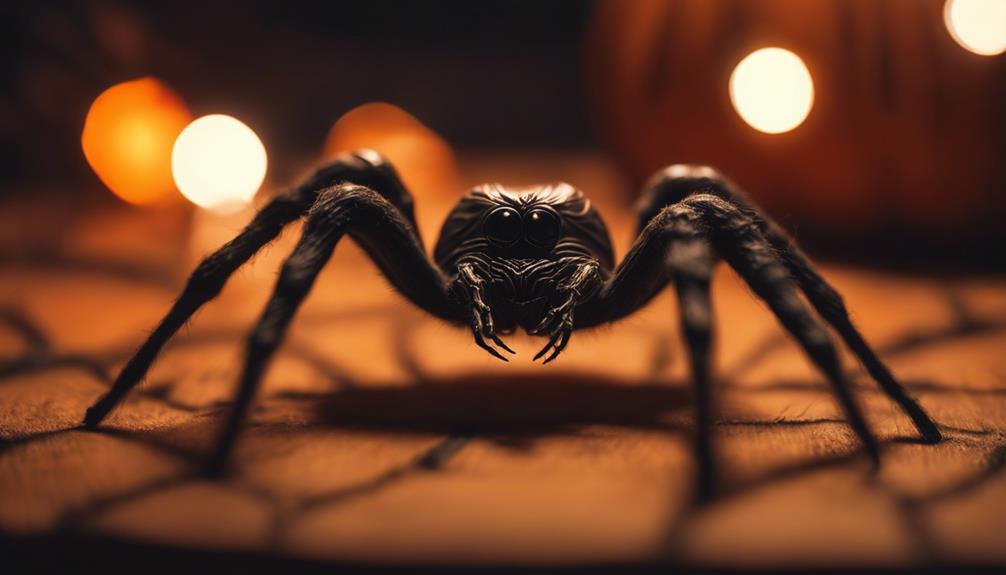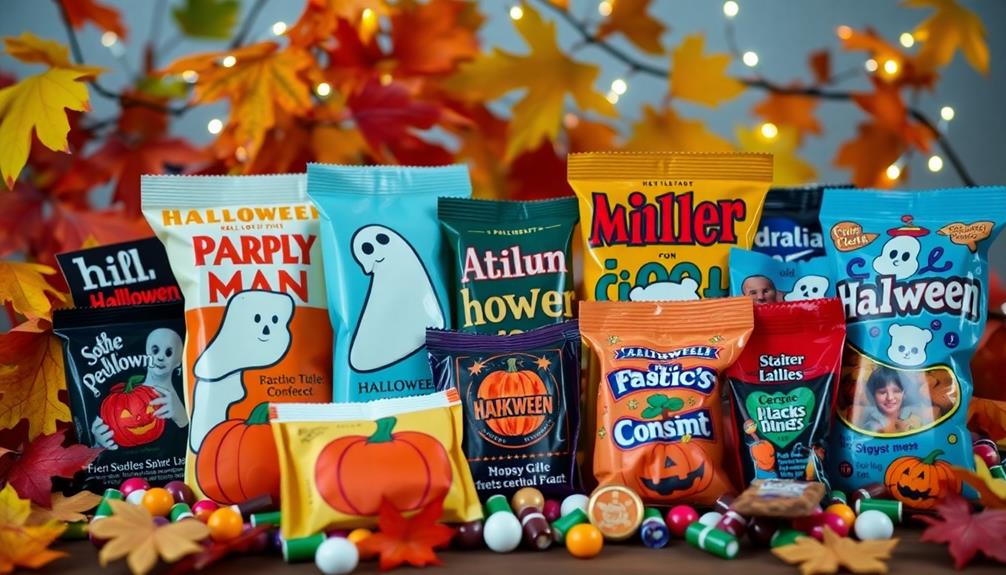Different countries adapt Halloween to their culture in fascinating ways. For instance, in Mexico, you'll find a joyful blend with Días de Muertos, focusing on celebrating life while honoring the deceased. In Japan, vibrant street parties and elaborate costumes take center stage, especially in districts like Shibuya. Ireland and Scotland keep their historical roots alive with Samhain, where communities light bonfires and wear costumes to ward off spirits. Meanwhile, Guatemala's Festival de Barriletes Gigantes showcases colorful kites representing communication with ancestors. Each celebration reflects unique cultural values and practices that connect the living with the past, revealing even more variations to explore.
Key Takeaways
- Japan emphasizes festive gatherings and elaborate costumes, merging local customs with Halloween influences for vibrant street parties, particularly in urban areas.
- Mexico uniquely blends Halloween with Días de Muertos, celebrating life through joyful remembrance and colorful traditions involving offerings for the deceased.
- The United Kingdom adapts Halloween with American influences, focusing on costume parties and trick-or-treating while moving away from historical customs.
- In Italy, Halloween is gaining popularity in urban areas, while traditional observances like Ognissanti involve visiting cemeteries to honor deceased loved ones.
- Guatemala's Festival de Barriletes Gigantes showcases large kites symbolizing communication with ancestors, merging indigenous beliefs with Halloween themes for community celebration.
Global Halloween Variations
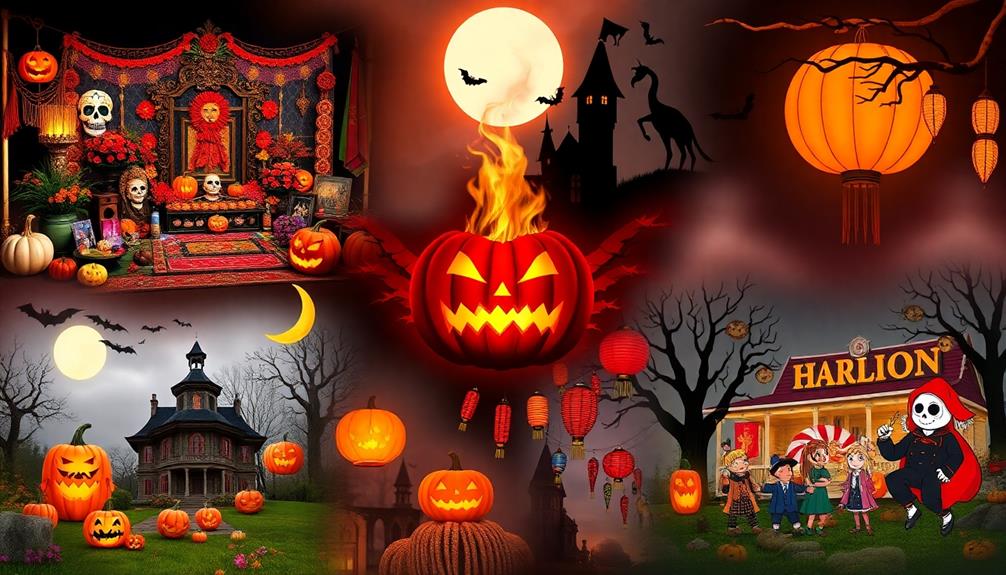
As Halloween spreads across the globe, it takes on unique forms that reflect local cultures and traditions. In Japan, for instance, you'll find vibrant street parties and elaborate costumes, especially in districts like Shibuya, where the focus is less on trick-or-treating and more on festive gatherings.
Meanwhile, Mexico beautifully blends Halloween with Días de Muertos, celebrating from October 31 to November 2. Here, people honor their deceased loved ones through offerings (ofrendas) while sporting costumes and decorating their homes.
In the United Kingdom, Halloween has been Americanized, leaning heavily on costume parties and trick-or-treating, shifting away from historical customs like performing for treats or carving turnips.
Italy, on the other hand, celebrates Ognissanti (All Saints Day) on November 1, where people visit cemeteries to honor the deceased, while Halloween's popularity grows mainly in urban areas with themed parties.
In Guatemala, the Festival de Barriletes Gigantes showcases large kites flying over cemeteries, emphasizing communication with ancestors and weaving Halloween themes into their cultural fabric.
These variations reveal the rich cultural diversity and creativity in how people celebrate and honor their traditions.
Mexico's Día De Los Muertos
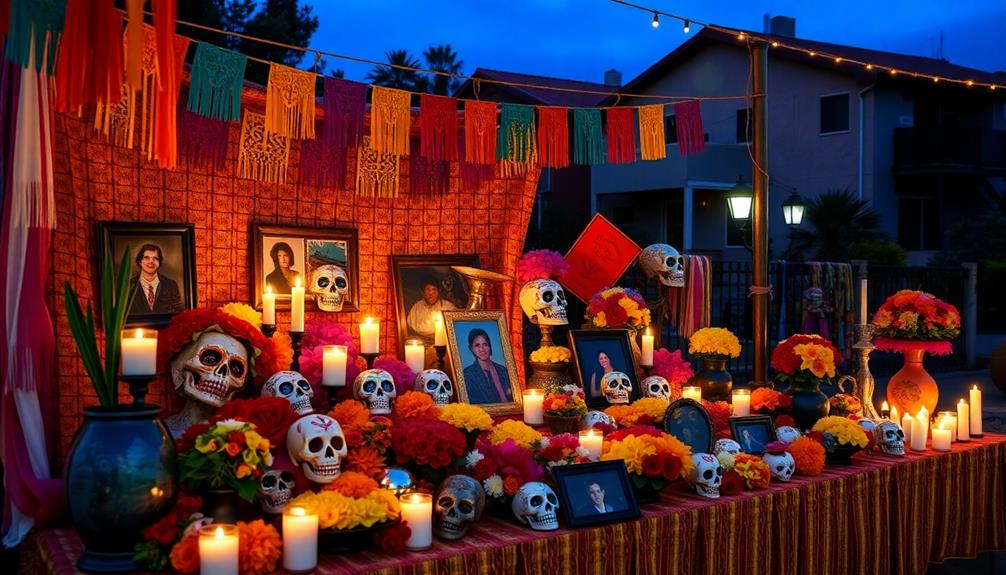
Mexico's Día de los Muertos stands out as a vibrant celebration that beautifully intertwines indigenous customs with Catholic traditions, honoring those who've passed away. Celebrated from October 31 to November 2, this holiday focuses on meaningful remembrance of deceased loved ones. Families create ofrendas, or altars, adorned with photographs, favorite foods, candles, and marigolds (cempasuchil) to welcome the spirits of the departed back to the living world.
Unlike Halloween's often generic portrayal of death, Día de Muertos emphasizes personal connections and the unique stories of individual ancestors. You'll find vibrant symbols like sugar skulls and calavera masks throughout the festivities. These symbols celebrate life, making the atmosphere more joyful rather than somber.
While Halloween traditions, such as costumes and trick-or-treating, have become popular in urban areas, Día de Muertos remains deeply rooted in Mexican heritage, reflecting a rich blend of indigenous traditions and cultural significance.
This holiday invites you to honor the past while celebrating the bond you share with those who came before you, creating a unique experience that resonates through generations.
Samhain in Ireland and Scotland
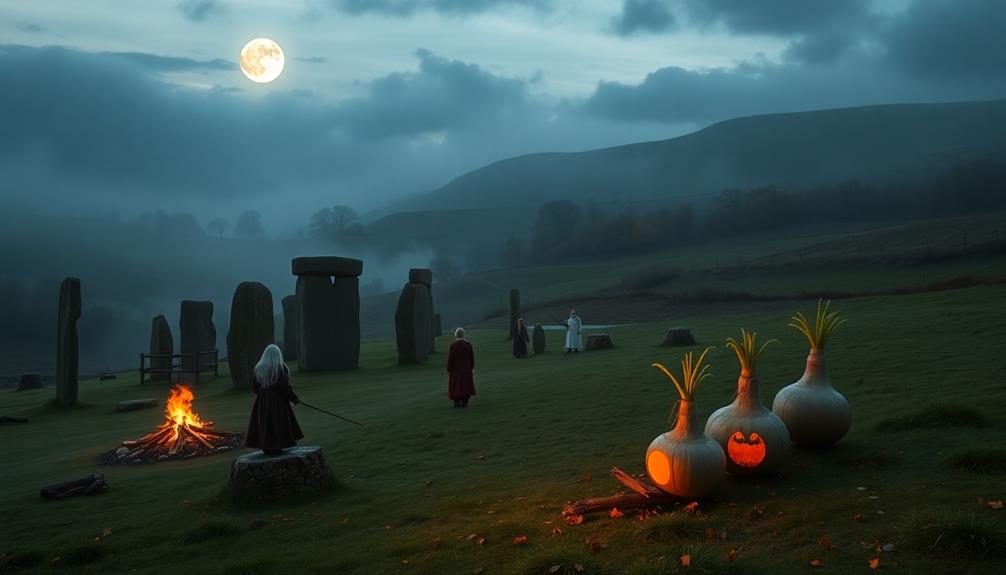
Samhain, celebrated from October 31 to November 1, marks an essential time in Gaelic culture, signaling the end of the harvest season and the onset of winter. This ancient festival, rooted in Celtic traditions, is when the boundary between the living and the dead is believed to dissolve.
You'd find communities lighting bonfires, a practice meant to ward off evil spirits. Wearing costumes during Samhain was another way to disguise oneself from these spirits, a custom that directly influenced modern Halloween customs.
Gatherings often involved opening burial mounds, thought to serve as portals for spirits to visit the living. This reflects deep ancestral connections, allowing you to honor those who've passed.
The rituals of Samhain also planted seeds for contemporary practices like trick-or-treating and pumpkin carving, which have become staples of Halloween celebrations today.
As you partake in Halloween festivities, remember that many of these customs have their roots in the rich history of Samhain, reminding us of the cycles of life and death that are celebrated in both Ireland and Scotland.
Embracing these traditions can deepen your appreciation for the holiday.
Halloween Celebrations in Japan

Halloween in Japan has evolved into a vibrant celebration that blends Western traditions with local cultural elements. Since Tokyo Disneyland introduced the holiday in 2000, the popularity of Halloween has skyrocketed, leading to unique festivities across the nation. Instead of traditional trick-or-treating, you'll find adult-oriented street parties and elaborate costume displays, particularly in bustling districts like Shibuya.
Here's a visual representation of how Halloween is celebrated in Japan:
| Aspect | Description | Key Locations |
|---|---|---|
| Origins | Tokyo Disneyland popularized Halloween | Nationwide |
| Main Activities | Costume parties & public parades | Shibuya, Osaka |
| Influences | Popular culture & anime | Various districts |
| Target Audience | Mostly adults | Urban areas |
| Community Engagement | Large gatherings & creativity showcase | Parks, streets |
These celebrations reflect cultural adaptation, as Japan incorporates local customs, making Halloween a time for community engagement and creativity. You'll witness imaginative costumes inspired by popular culture, creating a festive atmosphere that's distinctly Japanese while honoring Western roots.
Italian Traditions of Ognissanti

In Italy, Ognissanti, or All Saints Day, offers a poignant opportunity for families to honor their loved ones and reflect on the legacy of saints and martyrs. Celebrated on November 1, this day sees families visiting cemeteries to clean graves and light candles in memory of their deceased loved ones.
This communal atmosphere fosters deep reflection and respect, turning cemeteries into serene spaces of remembrance. Additionally, families often engage in discussions about financial planning and legacy, ensuring that their loved ones are taken care of even after they're gone, which can be likened to proper IRA Inheritance Rules that help avoid costly errors and maximize benefits.
Following Ognissanti, the Giorno dei Morti (Day of the Dead) on November 2 features regional rituals that vary across Italy. In Sicily, children receive sweets, while in Lombardy, families leave water for the dead, blending local customs with Christian traditions.
Traditional foods play a significant role during this time, with treats like pan dei morti, a spiced bread filled with nuts and dried fruits. This dish symbolizes the connection between the living and the dead, emphasizing the importance of remembrance.
Interestingly, Ognissanti also coincides with earlier pagan festivals celebrating harvests and the shift to winter, illustrating how Christian traditions have intertwined with local practices throughout history.
Guatemala's Festival De Barriletes Gigantes
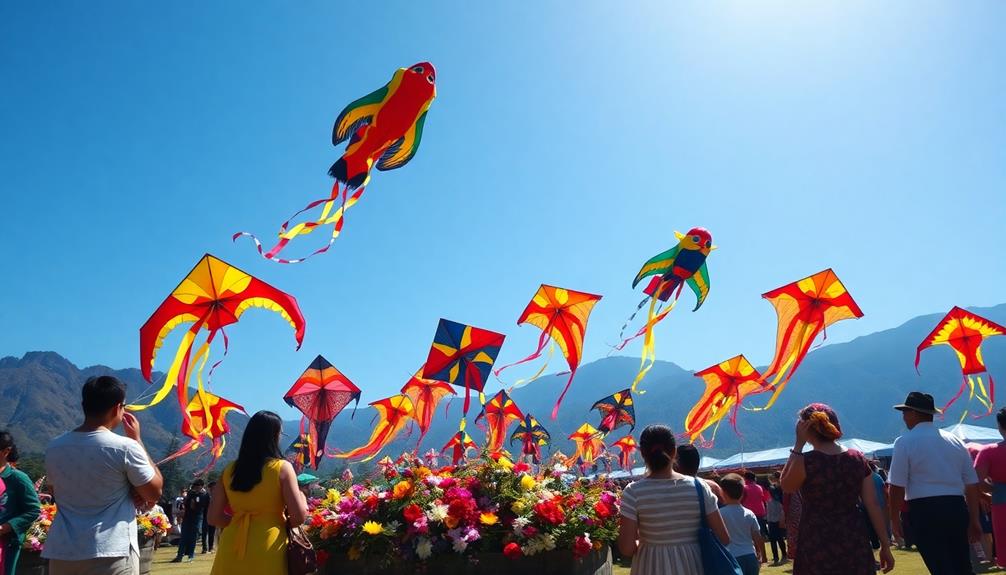
When you think about Guatemala's Festival de Barriletes Gigantes, imagine vibrant kites soaring high, each one rich with ancestral symbolism.
This tradition connects the living with their ancestors, as families gather to honor their loved ones during All Saints Day and Day of the Dead.
You'll see how kite flying becomes a powerful expression of both remembrance and community spirit.
Kite Flying Tradition
Celebrating the connection between the living and the dead, Guatemala's Festival de Barriletes Gigantes showcases a unique kite-flying tradition that honors deceased loved ones during All Saints Day and Day of the Dead.
This vibrant festival features large, handmade kites that soar over cemeteries, symbolizing the communication between the spiritual and physical domains. Dating back over 3,000 years, kite flying in Guatemala represents not only a means of remembrance but also a profound aspect of cultural identity.
Crafted from colorful paper and bamboo, these stunning kites can reach up to 30 feet in diameter, reflecting the creativity and craftsmanship of local artisans. Each kite often incorporates ancestral symbols and contemporary social issues, merging indigenous beliefs with Catholic influences.
Celebrations in towns like Santiago Sacatepéquez and Sumpango attract thousands of visitors who join in the lively festivities, creating an atmosphere filled with joy and reflection.
As you witness this incredible tradition, you'll understand how kite flying serves as a powerful expression of love and remembrance, connecting generations and honoring the legacies of those who've passed.
Ancestral Symbolism and Connection
Often, the kites at Guatemala's Festival de Barriletes Gigantes serve as vibrant canvases that reflect ancestral symbolism and deep cultural connections. Celebrated at the beginning of November, this festival highlights the importance of honoring ancestors during All Saints Day and the Day of the Dead. Each kite, crafted from paper and bamboo, features intricate designs that incorporate ancestral symbols alongside contemporary issues, embodying the community's cultural heritage.
As you watch the colorful kite displays soar above the cemeteries in Santiago Sacatepéquez and Sumpango, you'll feel the profound connection between worlds. These giant kites symbolize communication with the deceased, believed to carry messages from the living to the spirits. This practice illustrates how indigenous beliefs intertwine with Catholic practices, showcasing a unique blend of faith and tradition.
During the Festival de Barriletes Gigantes, you'll witness not just a celebration, but a heartfelt ritual that deepens the bond within families and communities. It's a time for reflection, remembrance, and connection, reminding everyone of the enduring presence of ancestors in their lives.
Unique Observances Around the World
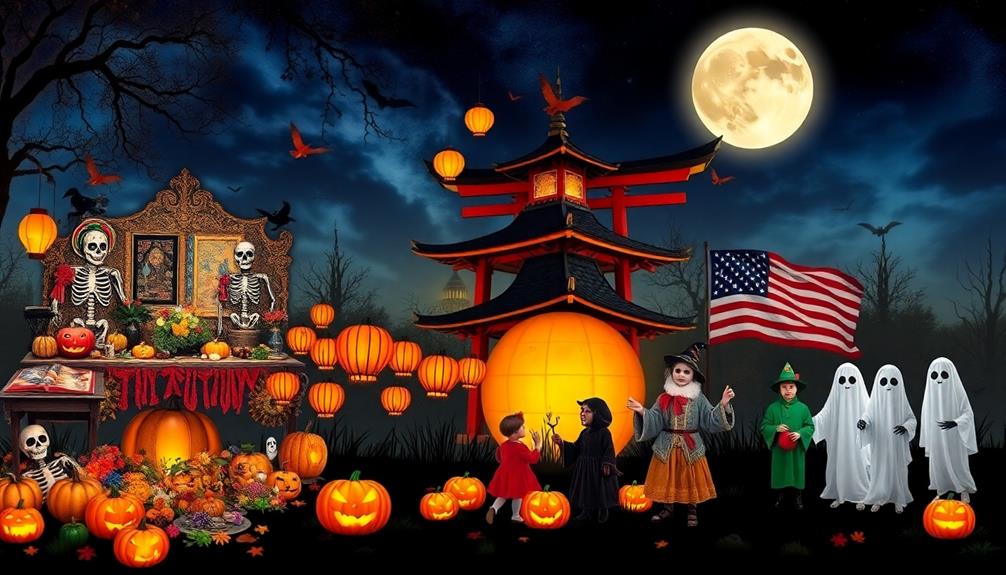
Halloween takes on many forms across the globe, showcasing a rich tapestry of cultural traditions that blend local customs with the holiday's themes of remembrance and festivity.
In countries like Mexico, families celebrate Día de los Muertos, combining Halloween traditions with joyful remembrance. They honor loved ones with colorful celebrations featuring ofrendas, marigolds, and sugar skulls.
In Guatemala, the Festival de Barriletes Gigantes sees large kites flown over cemeteries, symbolizing communication with the deceased.
Italy observes Ognissanti, where families visit cemeteries to honor saints and martyrs with shared meals and sweets.
Meanwhile, in the Czech Republic, Dušičky emphasizes familial connections by placing chairs around the fireplace for both living and deceased family members.
Here's a look at some unique observances around the world:
- Día de los Muertos in Mexico
- Festival de Barriletes Gigantes in Guatemala
- Ognissanti in Italy
- Dušičky in Czech Republic
- Halloween festivities in Japan
These customs and carnival-like events highlight how different cultures remember the deceased while fostering community bonds and celebrating life in their unique ways.
Frequently Asked Questions
How Is Halloween Celebrated in Different Countries?
You'll find Halloween celebrated uniquely around the world. In the U.S., it's all about trick-or-treating; in Mexico, Días de Muertos honors loved ones; while Japan focuses on commercial festivities and costume displays.
What Culture Influenced Halloween?
Halloween's influenced by Celtic traditions, Roman Catholicism, and Irish customs. You'll see elements like costumes and trick-or-treating evolving from these roots, showcasing how cultures blend over time to create the holiday you celebrate today.
Which Religion Adapted Halloween to Fit Their Own Customs?
You'll find that the Roman Catholic Church adapted Halloween by establishing All Saints Day, aiming to honor saints and replace pagan traditions. This led to unique celebrations in various cultures, blending customs with religious significance.
What Are the 2 Main Influences on How Halloween Is Celebrated?
Did you know that Americans spent around $9 billion on Halloween in 2018? The two main influences on how Halloween's celebrated are historical origins and cultural adaptations, merging local customs with contemporary practices to create unique experiences.
Conclusion
No matter where you are, Halloween's spirit of community and remembrance unites us all. You might think it's just a spooky night of costumes and candy, but it's so much more. Each culture adds its own unique twist, making the celebration richer and more meaningful. Embracing these diverse traditions not only honors our differences but also strengthens our connections. So, let's celebrate together, recognizing the beauty in how we each adapt this hauntingly delightful holiday.
